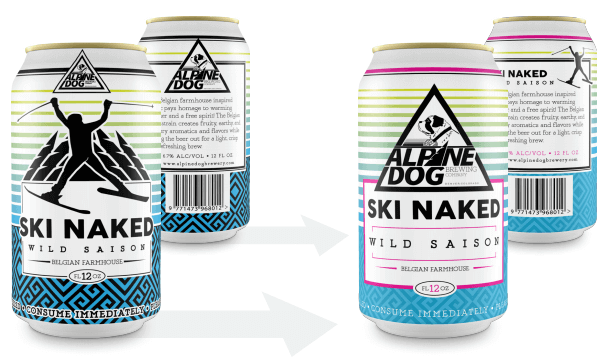Brewery Turns to Research for Label Design
Traditional forms of concept testing are focused on gathering customer feedback in response to a product idea prior to its launch. Concept testing can also be used for a variety of needs from product development to creative or design testing. In fact, researchers now have access to innovative concept testing methods that provide a more agile and iterative approach.
Further, many research methods are designed to answer specific questions and combining methods and conducting them iteratively can often provide even more robust insights. Foregoing the opportunity to combine methods could mean missing out on an easy approach to gaining comprehensive insights.
Using Research for the First Time
Alpine Dog Brewing Co., a locally owned craft brewery based out of Denver, was in the early stages of developing new labels for the upcoming release of a featured beer. With a significant number of craft breweries in Colorado, the competition is fierce. As a result, in order to compete with other breweries across the state, Alpine decided it needed to leverage the voice of the consumer through market research to assist in choosing the design of its new label. While consumer research is less common for smaller businesses of this type, Alpine Dog wanted to use research for the first time to determine the best label to move forward with into development to both please distributors and compete with other brands on the shelf.
Not having a traditional research budget, Alpine Dog considered low-cost solutions offered through DIY research tools. Yet, having never conducted research before, the company decided to forego those options in order to save the time and the hassle learning a tool and marketing research best practices. Searching for an agile vendor, they came across GutCheck, another business local to Colorado.
Alpine Dog began with six very unique label design concepts with various opportunities for refinements. GutCheck partnered with Alpine Dog and recommended a multiphase qualitative and quantitative concept testing strategy. Specifically, the quantitative phase would prioritize and identify the top performing design, while the qualitative phase would refine it in order to move forward with production.
Prioritizing Concepts
In the first phase of research Alpine Dog quantitatively tested its six design concepts – shown on images of cans and bottles – with a targeted audience of craft beer drinkers. Using configurable quantitative concept testing methodology that leverages statistical testing on key metrics to identify top performers, Alpine Dog was able to arrive at a list of prioritized concepts.
One label design performed significantly higher across key metrics and was chosen as the overall favorite against all other label designs. Open-ends showed that there were some areas for improvement, specifically related to clarity and certain design elements of the winning concept. As a result, these areas were used to inform the objectives of the qualitative phase.
Refining the Winning Concept
Alpine Dog was most excited about the qualitative phase in order to capture a greater level of depth by turning to the voice of the consumer. Using an online qualitative research group, GutCheck tested the winning label among the same target audience. A total sample size of 30 was ideal in order to get the most robust, open-ended feedback.
Findings showed the name of the beer was well liked and drew the most attention but overshadowed other elements of the design. Additionally, the design on the can appealed more to consumers than the one on the bottle. Further, the company branding elements were difficult to discern and the logo placement and product information left much to be desired. Some respondents reported that the combination of these elements caused confusion. However, Alpine Dog’s brand equities came through and beer consumers felt the overall design was a good fit for a craft beer brand.

A Successful Outcome
Alpine was able to use the results from both phases of research to make improvements to the winning design, creating a strong label to move into production. Additionally, the fact that the research was conducted quickly allowed it to use its new label design in early discussions with distributors and better plan for the next year’s production.
“The research has allowed us to focus our brand direction and push forward with production of our labels. Partnering with GutCheck’s agile approach was seamless,” says Gardiner Hammond, owner, Alpine Dog Brewing Co.
By combining agile methods, in addition to a hybrid research approach, the product teams were able to elevate their concept testing even higher. To see more detailed information that was uncovered during this multi-phase research approach, take a look at the report below.
Learn how GutCheck’s Persona Connector solution leverages a combination of survey and big data to bring actionability to persona development.
Follow us on
Check Out Our Most Recent Blog Posts
When Vocation and Avocation Collide
At GutCheck, we have four brand pillars upon which we build our business. One of those is to 'lead...
Reflections on Season 1 of Gutsiest Brands
Understanding people is at the heart of market research. Sure, companies want to know what ideas...
Permission to Evolve with Miguel Garcia Castillo
(highlights from Episode #22 of the Gutsiest Brands podcast) Check out the latest lessons from our...
1-877-990-8111
[email protected]
© 2023 GutCheck is a registered trademark of Brainyak, Inc. All rights reserved.
© 2020 GutCheck is a registered trademark of Brainyak, Inc. All rights reserved.



